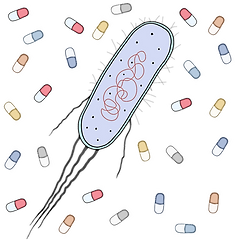MEMBRANE BIOENGINEERING AND TRANSPORT
Our research in a nutshell...
Cells in our body, and bacteria too, need to eat, breath and protect themselves against harmful substances and invaders - just like every other organism on earth. To perform these fundamental functions, the movement of molecules and ions into and out of the cell must be carefully regulated while preventing the entrance of cytotoxic molecules, like drugs. Remarkably, this intricate activity is effectively achieved by a semi-permeable barrier - the cell membrane - that is only a few nanometers thick! In our group we combine bioengineering, soft matter, and biophysical methodologies with state-of-the-art microfluidic approaches to elucidate the role and functionality of cellular membranes in health and disease. Research in our lab covers different topics including ion transport, antibiotic resistance, peptide-membrane interaction, and bottom-up synthesis of artificial cells.
Sounds interesting? Check out our research topics below.




Bottom-up synthesis of artificial cell models
_190221_jpg.jpg)
Despite advances in single cell analysis, interpretation of transport phenomena in the complex environment of living cells, and without interference from associated translocation pathways, is extremely challenging. In contrast, bottom-up synthetic biology offers an advanced approach for incorporating and analyzing specific biological systems (e.g., membrane proteins) in artificial cell models with well-defined and tunable membrane compositions. We combine advanced microfluidic techniques with soft matter and bioengineering concepts to develop novel cell-size synthetic models as a biologically-relevant tool for quantifying membrane transport phenomena in cells and bacteria.
Transport mechanisms in antimicrobial resistance

The simultaneous resistance of bacteria to structurally and functionally unrelated drugs, known as antimicrobial resistance, is one of the most serious threats to global public health with about 4.95 million deaths worldwide in 2019 alone. The exceptional resistance of pathogens to multiple antimicrobial agents arises from the unique molecular structure of their membrane that both passively and actively expels chemically-unrelated antibiotics through various transport pathways. We employ bottom-up bioengineering and biophysical approaches to elucidate the transport mechanisms that render the Gram-negative bacterium envelope such a formidable drug barrier. Particularly, we interested in studying the association between structure and function of the bacterial outer-membrane and efflux pumps.
Ion transport and selectivity

In cells, ionic flows are mediated by an array of selective transport proteins, like ion pumps and ion channels and harnessed to induce electrochemical gradients that power vital biochemical activities from nutrient uptake to energy conversion. Through quantifying ion transport across the lipid bilayer and ion channels we seek to understand how ion selectivity is gained and utilized by cells for generating and regulating electrochemical gradients.

Antimicrobial peptides
A promising approach to combat antimicrobial resistance is by interrupting the bacterium envelope integrity through inducing pore formation with antimicrobial peptides (AMPs). Nevertheless, even though thousands of AMPs have been discovered thus far (most of them from natural sources), only a few are in clinical use. We study the relationship between the structural properties of AMPs and their function as pore-inducing agents with an overarching aim to accelerate their rational design and use against antibiotic-resistant bacteria.
We gratefully acknowledge funding from previous and current sources:

